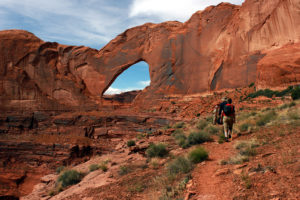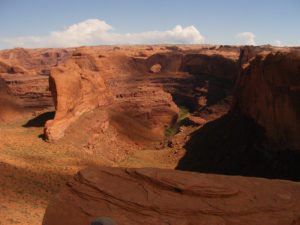 In our previous post, guest blogger Mitch Stevens, founder of Southwest Discoveries, which runs hiking tours in Arizona and adjoining states, wrote about what he calls the most beautiful hike in the Southwest: Coyote Gulch in southern Utah.
In our previous post, guest blogger Mitch Stevens, founder of Southwest Discoveries, which runs hiking tours in Arizona and adjoining states, wrote about what he calls the most beautiful hike in the Southwest: Coyote Gulch in southern Utah.
Today he writes about what he calls perhaps the single most impressive natural feature in the West: Stevens Arch. It’s part of his “Hiking the Escalante” series and makes me want to fly/drive/hike to southern Utah right now (or maybe when it cools down a bit). Reading his description of the sometimes rough and tricky terrain, though, I think I would want Mitch to lead the way. Here’s Mitch:
By Mitch Stevens
But for the adventurous, standing underneath the sublime spectacle of Stevens Arch — my nominee for the top spot — is unparalleled.
This enormous bulk of an arch is located along the lower Escalante River, just beyond the boundaries of Escalante Grand Staircase National Monument.
The Escalante is an untraveled land of spectacular canyons, amazing geology and light and shadow. The Escalante was actually the last river of its size to be discovered in the lower 48.
The Hike Begins
We entered the canyon via “Crack in the Wall,” 36 miles south of U.S. 12, off Escalante Grand Staircase’s Hole in the Rock Road. To access this hike, we turned left at Forty Mile Ridge Road and followed it for 4.3 miles to the trailhead.
After an easy two miles, we reached the rim of the canyon. From this vantage point, it seemed impossible to make it to the canyon floor safely. The “crack” in the wall is exactly that, a crack. We lowered our packs down the rock wall, tied on to a 30-foot rope.
>Our group, one by one, squeezed through a space about 18 inches wide to overcome this obstacle. We descended a huge red sand dune to reach the canyon bottom, a hike which featured exhilarating views of sculpted red sandstone cliffs and the gigantic Stevens Arch in the distance.
A breathtaking desert landscape of red rock towers and cliffs will unfold. At the canyon bottom, head downstream a short distance to the Escalante River. It is important to head left here; a right turn will eventually land you at the mouth of the Escalante near Lake Powell.
Stevens Arch
It won’t be long before the gigantic monolith of Stevens Arch makes its grand appearance. The eye of Stevens Arch, 220 feet across and 160 feet tall, looms above the Escalante River like a sentinel. The stream snakes and twists dramatically in this tortured landscape where every bend of the canyon reveals another spectacle to behold.
At some point in the next quarter of a mile, look to the right to locate a route through the tamarisk trees to gain a use trail and a steep scramble up the talus slopes on the east wall of the canyon. There is only one area where the cliffs are sufficiently broken with loose talus and there are one or more paths going up.
As you near the bench above, work your way to the right a bit to overcome the last of the rock obstacles. The path will switch back up the crumbly cliffs and lead to the top of the Kayenta Formation, a reddish brown rock which comprises the middle third of the three-part series that makes up the Glen Canyon Group.
The rock directly above the Kayenta is the Navajo Sandstone, a geologic layer which frequently occurs as spectacular rounded domes, bluffs and immense vertical cliffs up to 2,200 feet high. Stevens Arch, as well as neighboring Coyote Gulch and the Escalante River canyons, was eroded out of Navajo Formation.
Glorious Scenery
As you continue to gain elevation and reach the highest ledge, the scenery will become even more glorious. The huge bulk of Stevens Arch will now appear to be on the same level as the ground you are walking on. As you work your way along the ridge line, the route will resemble a super highway in comparison to the scrambling you completed just a few minutes earlier.
Stevens Arch is one of the largest arches in the world, ranked number four by some estimates. From this vantage point, it resembles a window blasted out of a wall of rock. The view of the arch almost directly in front of you, towering above the Escalante River as well as the splendid surrounding scenery, is incomparable. It is one of the most dramatic I’ve ever seen.
Continue your hike and in no time, you will be directly underneath the massive span. Take this opportunity to rest for a while and take in the views. Looking down the other side of the arch, you will observe the long sinuous Stevens Canyon winding its way to the Escalante, originating on the southern border of Capitol Reef National Park.
This is true desert wilderness where only the hardiest desert rats dare venture. Speaking of desert rats, one member of our group couldn’t resist the urge of climbing even higher onto the lower part of the arch, making an already superb hike even more interesting!
Carefully retrace your steps back down to the Escalante River, lower Coyote gulch, the trail skirting the red sand dunes to Crack in the Rock and the trailhead, capping one of the most beautiful and memorable hikes in North America that one can only experience when hiking Utah.
Turn up your speakers and enjoy “Walking in a Dream, “a five-minute cyber journey
showcasing the sublimity of Stevens Arch and the Escalante Grand Staircase National Monument.












3 Responses to Hiking Utah: The Incomparable Stevens Arch